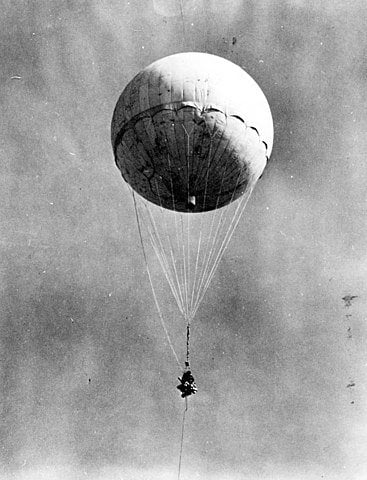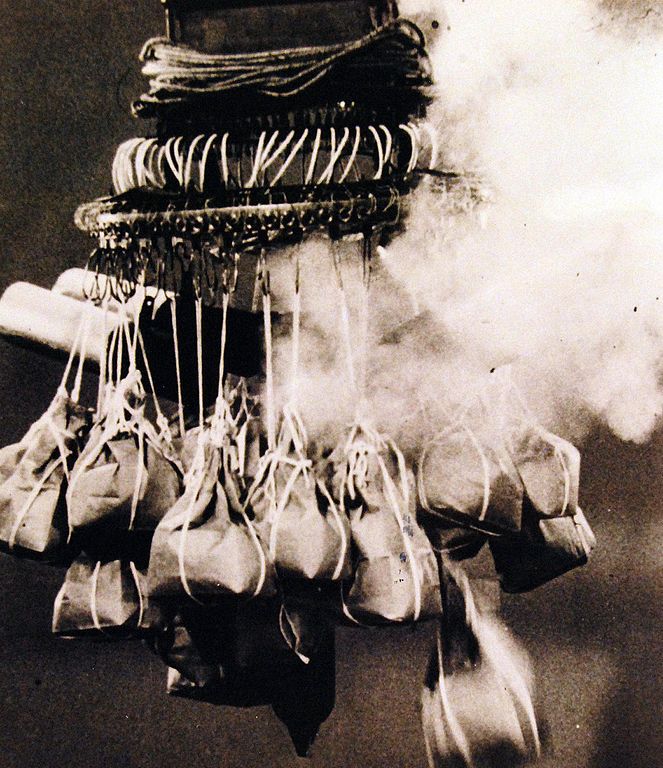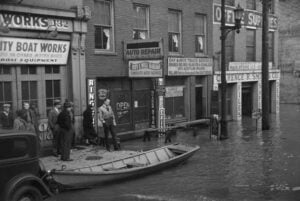When Japanese bomb balloons landed in Michigan
During World War II, the Japanese military launched thousands of Fu-Go balloon bombs across the Pacific Ocean, hoping to cause damage and panic in the United States.

A Japanese balloon, with bombs attached, found near Bigelow, Kansas, February 23, 1945.
During World War II, the Japanese military launched thousands of balloon bombs across the Pacific Ocean, hoping to cause damage and panic in the United States. Most of the balloon bombs failed their objectives. There were even downed Japanese Fu-Go Balloons in Michigan.
Background
The balloon bombs were a weapon developed by the Japanese military in response to the Doolittle Raid, a US air strike on Tokyo in 1942.
The surprise Doolittle Raid humiliated the Japanese and dealt a blow to the morale of Japanese citizens.
The Japanese government wanted revenge. However, after the Battle of Midway, the Japanese military didn’t have the capability to bomb the US mainland in a long-range strike.
In the 1920s, a Japanese researcher named Wasaburo Oishi discovered a west-to-east current over 35,000 feet in the air, a jet stream. When Japanese strategists were searching for retaliation ideas, they stumbled upon Oishi’s research. They decided to utilize the strong jet stream current to strike North America directly.

How Fu-Go Balloons operated
The bomb balloons were named Fu-Go balloons. Many were manufactured by child labor.
According to the Detroit Free Press,
“The balloons developed for the mission were 33 feet in diameter and filled with about 19,000 cubic feet of hydrogen. They were made out of layers of thin, fibrous paper made from mulberry bushes that, pasted together with a vegetable-based glue, made for a tough, canvas-like balloon material.
Hanging from the balloons by ropes was an elaborate “chandelier” featuring fuses, switches, batteries and, typically, one high-explosive bomb and two incendiary bombs. Ringing the chandelier were 7-pound sandbags.
The sandbags were ballast. When the balloons dropped below a certain height, an onboard altimeter would trigger a small charge, dropping a sandbag from the balloon.
As the balloons dropped their last sandbags and neared the ground, other small flash bombs would trigger to drop the incendiary bombs and high explosive. As the last bomb was dropped, a long, 64-foot fuse was also lit, leading to another flash device to destroy the balloon.”
Japanese Fu-Go Balloons reach America
In November 1944, the Japanese started releasing the Fu-Go balloons from their main island, Honshu. The balloons were released in the winter months when the jet stream would carry them the farthest distance.
The Japanese military hoped the balloons would spread terror across the United States and kill civilians. They also released the Fu-Go balloons to start wildfires in the Western States, which would divert precious wartime resources from the United States to fight the fires.
Two days later, the US Navy spotted balloon debris off the coast of California. Throughout November and December, citizens in the western states started reporting balloon sightings.
The US government didn’t want panic to spread throughout the country, so they created a news blackout on any balloon sightings. Government officials also didn’t want the Japanese to think their Fu-Go balloon campaign was working.

Japanese Fu-Go Balloons in Michigan
In February, outside North Dorr, Michigan Bob and Ken Fein and their friend Larry Bailey noticed a large balloon floating overhead that was about to crash. Joe Wolf, a family friend of the Bailey family, agreed to take the boys to find the wreckage. They found the deflating wreckage and put its charred remains in the back of Wolf’s pickup. They shoved the balloon into the cellar of the Feins’ house where it filled up the room.
After the Feins’ mother saw it in the basement, she called the local priest. The priest suggested they report it to the police. The next day, the US military sent agents to pick up the wreckage. The agents told the boys not to tell anyone about it.
The boys thought it was a weather balloon, but 15 years later they learned its true identity. They had played around with a Japanese bomb balloon.
Another balloon landed in a Detroit suburb where it caught an empty lot on fire.
Legacy of Fu-Go Balloons
In the Western States, the balloons failed to create wildfires. Most of the balloons landed in the Pacific Northwest, where during the winter months, rain prevented fires.
Only six American citizens were killed by the balloons. In Oregon, Elsye Mitchell, 26; Sherman Shoemaker, 11; Eddie Engen, 13; Jay Gifford, 13; Joan Patzke, 13; and Dick Patzke, 14; stumbled upon a balloon wreckage. It had probably been on the ground for two months. One of the children, poking through the wreckage accidentally set off one of the explosives, killing all six of them.
Other than the six casualties, the Japanese terror campaign failed. With strict media censorship, the American public was mostly unaware of the balloons.
Overall, the Japanese launched more than 9,300 balloon bombs west. Only 284 were found in North America, though researchers believe perhaps 1,000 made it across the Pacific.
People across North America are still discovering Fu-Go wreckages. In 2014, forestry workers in the mountains near Lumby, British Columbia, in Canada discovered the metal canopy remained of a Japanese bomb balloon. A Canadian naval bomb squad detonated the fragments as a precaution. Another wreckage in British Columbia was discovered in 2019.
The North Dorr, Michigan Balloon is now in a box at the Byron Center Museum in Byron Center, Michigan.
Sources/Further Reading:
When the Japanese Bombed North Dorr, Michigan (warhistoryonline.com)




Love learning something new , had never heard this before. Excellent research !